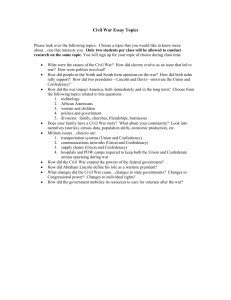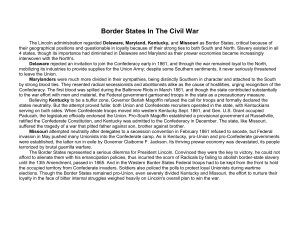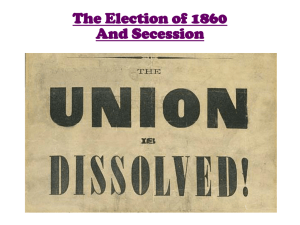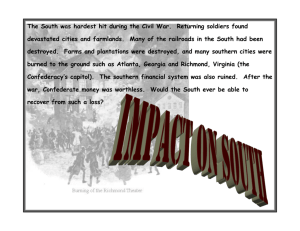COS Standard14
advertisement
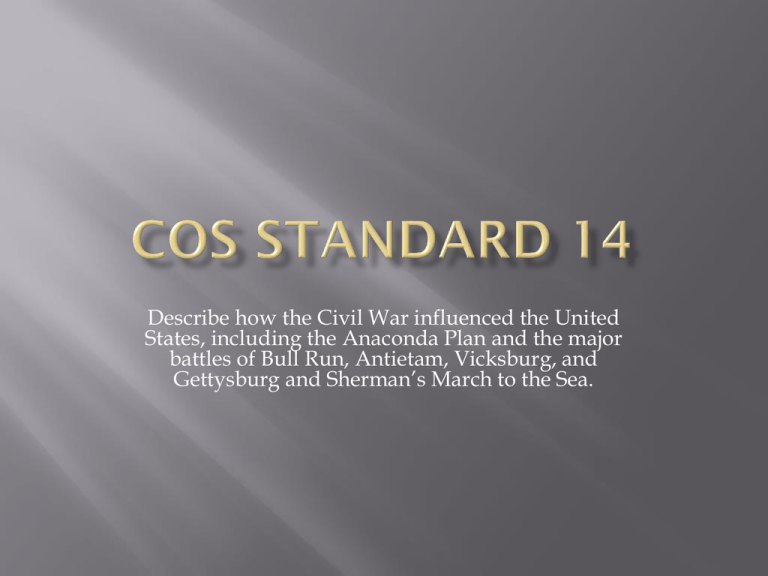
Describe how the Civil War influenced the United States, including the Anaconda Plan and the major battles of Bull Run, Antietam, Vicksburg, and Gettysburg and Sherman’s March to the Sea. Chapter 10-5 and Chapter 11 Advantages Larger population Easier to raise an army Easier to support the war effort Industries and factories Railroads Controlled national treasury Issued Greenbacks (inflation small 80%) Strong naval tradition Most of the navy is from the north Shipyards are located in the north. Disadvantages Military is not as strong Advantages Producing food Strong military tradition 7 military colleges were located in the South Disadvantages Smaller population South has one factory Distributing food Lacked Railroads Lacked money to pay for the war Raised money by taxing trade until blockade Taxed people directly Printed paper money, high inflation (9,000%) Defensive War of Attrition Pick battles carefully Attack and retreat when needed Avoid large battles Make the Union use its resources until it became tired of the war and agreed to negotiate Winfield Scott’s plan Named after Anaconda: Slowly strangles its prey to death Union blockade Southern ports Send gunboats down the Mississippi River to divide the Confederacy South would run out of resources and surrender 16th President of the US Elected in 1860: reason the South seceded from the Union President during the Civil War Lawyer From Illinois Tried to run for a Senate seat in 1858, lost to Stephen Douglas Republican President of the Confederacy during the Civil War Senator from Mississippi General in the US Army At first he was the commander in the west Because of his abilities/winning in the west, Lincoln promoted him to overall commander of all the US troops General in Confederate Army From Virginia Was reluctant to join CSA, but said if his state left the Union, he must go with it. Confederate military leader Lee’s right hand man Gets his nickname because he and his men stand like a stonewall ready to fight Dies at the Battle of Chancellorsville by his own men Jefferson Davis, Robert E. Lee and Stonewall Jackson Union Military Leader Sherman’s March to the Sea 60 miles wide of destruction through Georgia Other Names for the Civil War War Between the States Other Names for the South Confederacy CSA/CS Confederate States of America Other Names for the North United States of America USA/US Union Started: April 12, 1861 (Fort Sumter) Ended: April 9, 1865 (Appomattox Courthouse) United States 21 states total California Oregon Kansas Iowa Minnesota Michigan Ohio Indiana Illinois Wisconsin West Virginia Pennsylvania Delaware New Jersey New York Rhode Island Massachusetts New Hampshire Vermont Maine Connecticut Border States 3 states total Missouri Kentucky Maryland Confederate States 11 states total Texas Alabama Arkansas Mississippi Georgia Louisiana Tennessee North Carolina South Carolina Florida Virginia Lincoln thought Delaware was safe. He worried about Maryland, Kentucky, and Missouri. If Maryland seceded from the Union, then Washington D. C. would be surrounded by the Confederacy. Lincoln takes military control of Maryland. Kentucky decided to remain neutral. Lincoln says he will leave Kentucky alone as long as the Confederacy does. Eventually, the Confederacy will occupy Kentucky. The invasion angered the Kentucky legislature. They vote against the Confederacy. Some voted to secede from the Union and join the Confederacy. Missouri voted to stay with the Union. Must have military occupation to keep Missouri with the Union.
